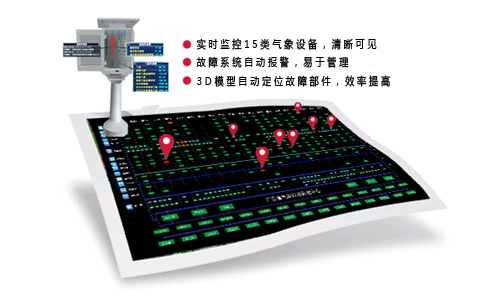
When the precipitation reaches the threshold, monitoring and urban waterlogging risk management system will kick into gear and push early warning information to decision-makers. Transportation and municipal departments will take swift action, which will markedly mitigate disaster risks.
In the meanwhile, meteorological departments collect, apply, analyze and compute meteorological data. In terms of application terminal, smart meteorological services have transformed our lives.
Numerical weather prediction
As technologies evolve, people have come to realize the flowing nature of the atmosphere and observe that its basic motion complies with hydromechanics.
Simply put, numerical weather prediction resembles solving a mathematical problem.
In 1999, NWP in China has embarked on independent development, kick-starting GRAPES research.
In 2016, the formally operationalized GRAPES system has become a landmark achievement for NWP technical capabilities improvement.
On June 15, 2017, numerical prediction cloud has been formally put into operation. Meteorological departments across the nation can rapidly get hands on high resolution NWP data, lending a hand to refined forecasting capabilities.
Information-based services
In the past one hundred years, meteorological observation has evolved from naked eye observation to automatic observation. Computing method has evolved from manual computing to the application of super computers.
As a matter of fact, smart meteorology needs to rely on a sea of data, and excel at collection, storage, and handling of those data. In terms of hardware, meteorological departments have constructed telecommunication system. In terms of software, CIMISS is a comprehensive system developed by CMA.
Furthermore, national high performance computer peak computing capacity has reached 1360.7 trillion times per second. CMA has established a high computer resources real-time monitoring system and limited mobilization capacity.
Smart Grid Forecast
In the past, people could rely on data in meteorological monitoring stations to forecast the weather, but the stations were unevenly distributed. Nowadays, on the strength of AI and big data technologies, a colossal network bearing forecasting service data is unfolding in an evenly distributed manner. Right now, the spatial resolution of the network has reached 5km 5km. in the temporal resolution, it can enable weather forecast for the future 10 days at 3–hour interval.
For example, the general public can have access to hourly weather forecast in Beijing via the Wechat APP underpinned by smart grid forecasting services.
Currently, automatic and smart levels of weather forecast have been markedly lifted. Researchers in China are exploring weather forecast at 1-hour interval within 72 hours, extend extreme daily temperature forecast range to 15 days, and experiment with 2.5km 2.5km grid point weather forecast in the entire country,and 10km 10km forecast across the globe.

3D online monitoring platform
Agricultural services
In many rural places, modern facility agriculture can connect rural climate observation, Internet technologies and Internet of things, enabling real-time data monitoring, real scene monitoring, and keep tabs on meteorological data and future trends.
Currently, CMA smart agro-meteorological services have covered 2.4 million users, playing a key role in crop growth condition management, meteorological disaster prevention, agricultural product sales, and agro- meteorological insurance.
For instance, agro-meteorological refined smart service platform in Chongqing leverages mobile phone APP, website, and other formats to establish professional expert alliance, and provide refined and personalized services for agricultural enterprises and other users.
Public services
A growing number of appliance and facilities are based on Internet of Things and sensors, connected to CPU with smart meteorological functions. All these are inseparable from meteorological big data.
Right now, meteorological departments collect and analyze user demand, Internet observation data, develop smart meteorological service engine suited to service demand, and provide products adaptable to user location, risk preference, and behavior objectives.
In Guangdong, mobile phone APP can provide precipitation services at minute scale intervals, hourly grid point forecast, and provide refined services for parents and students. In Shanghai, residents can have access to meteorological services encompassing real-time meteorological conditions, risk and early warning. In Beijing, “ Beijing serves you” system can be docked with all manner of warning information, and realize the dissemination of early warning information within 10 minutes to all channels.

wearable meteorological device
Professional services
In Shanghai, based on Beidou satellite navigation technology, coupled with comprehensive technologies like meteorology and computer analysis, nationally developed ocean-going meteorological system can select the best route for those vessels, provide timely and accurate marine weather data, and ensure the security and timeliness of the ocean-going vessels.
What’s more, smart meteorology can be connected with billions of facilities, machines and systems of energy production terminal, energy transmission and consumption terminal, and others on the strength of Internet, sensors, control procedures, and software application. For example, in Hunan, meteorological departments can extend the meteorological application of power generation data or electrical power sector to load prediction, repair and arrangement, and disaster prevention and mitigation.
Currently, CMA has conducted wide-ranging collaboration with Ali Cloud and Jingdong big data, enabling more in-depth information sharing, and smart meteorological services. In the near future, smart meteorology will penetrate into smart forestry, tourism and construction sectors, even engendering the advent of new forms of services.
Reporter: Shen Minxia, Niu Yanyuan, Guan Chenggong, Liu Zhao, Zhang Gemiao, Xue Feng
Editor: Liu Shuqiao